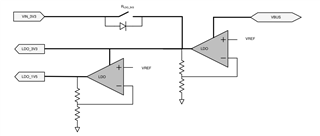Other Parts Discussed in Thread: BQ25792, TIDA-050047, TIDA-050045
Hi teams
I have few questions about TPS25750:
- TPS25750 have several GPIO pins, is it possible to leverage these GPIO for some basic logic control? For example, GPIO pin output high level if some condition have been met.
- With TI battery charger (take BQ25792 as example) for DRP application, TPS25750 will automatically adjust BQ25792 OTG output voltage? (the high voltage source power is powered by BQ25792 through discharge the battery with OTG mode.)
- For DRP application with BQ battery charge, is it possible to provide 3.3V for TPS25750 with BQ25792 to reduce one 5V regulator? As TPS25750 could adjust OTG output voltage, 5V also could provided by BQ25792
Thanks in advance.



